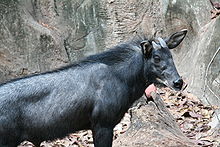Mainland serow
It has been suggested that Himalayan serow be merged into this article. (Discuss) Proposed since February 2022. |
| Mainland serow | |
|---|---|

| |
Conservation status
| |
| Scientific classification | |
| Kingdom: | Animalia |
| Phylum: | Chordata |
| Class: | Mammalia |
| Order: | Artiodactyla |
| Family: | Bovidae |
| Subfamily: | Caprinae |
| Genus: | Capricornis |
| Species: | C. sumatraensis[1]
|
| Binomial name | |
| Capricornis sumatraensis[1] (Bechstein, 1799)
| |
| Synonyms | |
| |
The mainland serow (Capricornis sumatraensis) is a serow species native to the Himalayas, Southeast Asia and China.[2][1]
Taxonomy[]
In 1831, Brian Houghton Hodgson first described a goat-like animal with short annulated horns occurring in montane regions between the Sutlej and Teesta Rivers under the name "Bubaline Antelope".[3] As "Bubaline" was preoccupied, he gave it the scientific name Antelope thar a few months later.[4] When William Ogilby described the genus Capricornis in 1838, he determined the Himalayan serow as type species of this genus.[5]
Characteristics[]
This section does not cite any sources. (November 2019) |
The mainland serow possesses guard hairs on its coat that are bristly or coarse and cover the layer of fur closest to its skin to varying degrees. The animal has a mane that runs from the horns to the middle of the dorsal aspect of the animal between the scapulae covering the skin. The horns are only characteristic of the males and are light-colored, approximately six inches in length, and curve slightly towards the animal's back. The mainland serow is quite large and has been known to grow to be six feet long and three feet high at the shoulder, and an adult typically weighs over 150 kg.
Distribution and habitat[]
The Himalayan serow inhabits hilly forests above an elevation of 300 m (980 ft), but descends to 100 m (330 ft) in winter.[6] It prefers elevations of 2,500–3,500 m (8,200–11,500 ft) in the Himalayas.[7]
This section does not cite any sources. (November 2019) |
The mainland serow is found in central and southern China, Vietnam, Cambodia, Laos, Myanmar, Thailand, and in Indonesian Islands of Sumatra. Its distribution follows forested mountain ranges.
The mainland serow inhabits steep, rugged hills up to an elevation of 4,500 m (14,800 ft). It prefers rocky terrain but is also found in forests and flat areas. It is able to swim to small offshore islands. This species has a moderate level of tolerance to human disturbance, and could persist well in habitat fragments and secondary forests, though avoiding farmlands.
Behaviour and ecology[]
This section does not cite any sources. (November 2019) |
The mainland serow is territorial and lives alone or in small groups. It usually stays in a small area of only a few square miles where it grazes on grass, shoots and leaves from along beaten paths. It marks its territory with droppings and markings. It is most active at dawn and dusk, and spends the rest of the day in thick vegetation.
The mainland serow gives birth to a single young usually in September or October. The gestation period is about eight months.
Conservation[]
The mainland serow is protected under CITES Appendix I.[2]
References[]
- ^ a b Mori, E.; Nerva, L. & Lovari, S. (2019). "Reclassification of the serows and gorals: the end of a neverending story?". Mammal Review. 49 (3): 256–262. doi:10.1111/mam.12154.
- ^ a b c d Phan, T.D.; Nijhawan, S.; Li, S. & Xiao, L. (2020). "Capricornis sumatraensis". IUCN Red List of Threatened Species. 2020: e.T162916735A162916910. doi:10.2305/IUCN.UK.2020-2.RLTS.T162916735A162916910.en. Retrieved 16 January 2022.
- ^ Hodgson, B.H. (1831). "On the Bubaline Antelope. (Nobis.)". Gleanings in Science. 3 (April): 122–123.
- ^ Hodgson, B.H. (1831). "Contributions in Natural History". Gleanings in Science. 3 (October): 320–324.
- ^ Ogilby, W. (1836). "On the generic characters of Ruminants". Proceedings of the Zoological Society of London. 8: 131–140.
- ^ Choudhury, A. (2003). "Status of serow (Capricornis sumatraensis) in Assam" (PDF). Tigerpaper. 30 (2): 1–2.
- ^ Aryal, A. (2009). "Habitat ecology of Himalayan serow (Capricornis sumatraensis ssp. thar) in Annapurna Conservation Area of Nepal" (PDF). Tigerpaper. 34 (4): 12–20.
External links[]
| Wikimedia Commons has media related to Capricornis sumatraensis. |
- IUCN Red List vulnerable species
- Serows
- Mammals of Indonesia
- Mammals of Nepal
- Mammals of Thailand
- Mammals of China
- Mammals of Bhutan
- Mammals of Malaysia
- Fauna of Southeast Asia
- Mammals described in 1869
